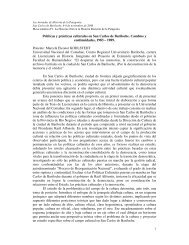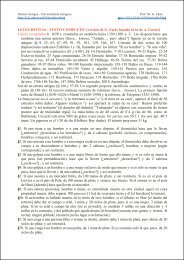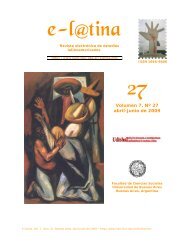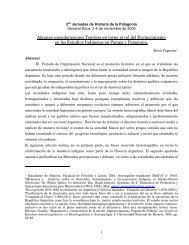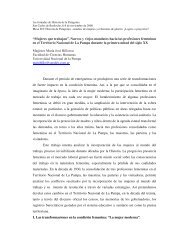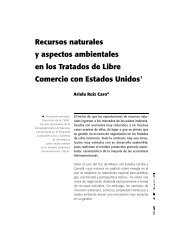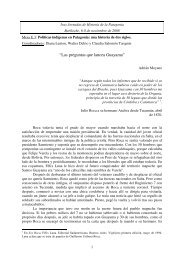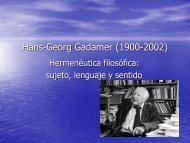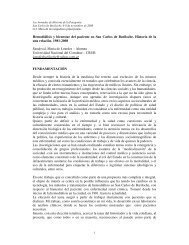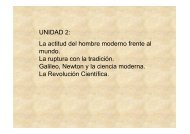Universidad Nacional del Comahue - Facultad de Lenguas ...
Universidad Nacional del Comahue - Facultad de Lenguas ...
Universidad Nacional del Comahue - Facultad de Lenguas ...
Create successful ePaper yourself
Turn your PDF publications into a flip-book with our unique Google optimized e-Paper software.
4<br />
Coherencia discursiva a través <strong>de</strong>: nexos o conectores intra-oracionales:<br />
(CONTRASTE: although, whereas...; ADICIÓN: “both X and Y”; “X as well as Y; “not<br />
only X but also Y”); CONSECUENCIA: Efecto-Causa: because, because of, since, due<br />
to...; ALTERNATIVA: “either..or, neither...nor…; indicadores <strong>de</strong> PROPÓSITO: “in<br />
or<strong>de</strong>r to/that”; “so that”, “so as to”, “with the purpose of...”; indicadores <strong>de</strong><br />
EXPLICACIÓN O REFORMULACIÓN <strong>de</strong> un concepto: i.e., that is, “that is to say”, “in<br />
other words”; indicadores <strong>de</strong> EJEMPLIFICACIÓN: e.g., for instance, for example,<br />
such as…; indicadores <strong>de</strong> CONDICIÓN: whether, if, unless, “provi<strong>de</strong>d that...”, “so<br />
long as...”.<br />
Coherencia discursiva a través <strong>de</strong>: nexos o conectores inter-oracionales: ADICIÓN:<br />
Besi<strong>de</strong>s, Furthermore, In addition, Moreover; CONTRASTE: However, Nevertheless,<br />
On the other hand; CONSECUENCIA O CAUSA-EFECTO: Thus, Then, Therefore,<br />
Consequently, Hence; indicadores <strong>de</strong> SECUENCIA: first, firstly, to begin with, then,<br />
later, eventually, finally; indicadores <strong>de</strong> RESUMEN O CONCLUSIÓN: briefly, in<br />
conclusion, summing up, in short.<br />
Funciones específicas <strong>de</strong> “it”: referente, sujeto anticipador, objeto anticipador,<br />
enfático.<br />
Funciones específicas <strong>de</strong> “to”: dirección (a/hacia), propósito (para/con el<br />
propósito <strong>de</strong>), indicador <strong>de</strong> verbo infinitivo (to make, to give), temporalidad (to the<br />
end of the century).<br />
Construcción compleja con “to”: *frase verbal principal + frase nominal + infinitivo<br />
(to + verbo)] (prove + theory+ to be (correct); let + something + happen).<br />
Formas pasivas: [be + verbo participio]: is <strong>de</strong>fined, was <strong>de</strong>signed; [verbo modal +<br />
be + verbo participio]: can be <strong>de</strong>fined, should be consi<strong>de</strong>red; pasivas que expresan<br />
el agente: [is governed by…]; pasivas sin agente (uso <strong><strong>de</strong>l</strong> “se” en la versión en<br />
castellano); lectura <strong>de</strong> pasivas complejas: *…is thought to be…+; pasivas con “it”: *it<br />
is believed that…+.<br />
Tiempos verbales: presente simple; presente continuo [be + verb-ing]; presente<br />
perfecto [Aux..have/has + participio –ed/en(-ado/ido)]; presente perfecto continuo<br />
[Aux.have/has + been + verb-ing]. Pasado simple; pasado continuo: [was/were +<br />
verb-ing]; pasado perfecto [had + participio –ed/en (ado/ido)]. Futuro simple:<br />
[aux.will + v. infinitivo]; futuro continuo [aux.will + be v.-ing]; futuro perfecto:<br />
[aux.will + have + v. participio (-ado/ido)].<br />
7. Propuesta metodológica<br />
Los contenidos <strong>de</strong> la materia serán <strong>de</strong>sarrollados teniendo en cuenta los objetivos planteados<br />
al comienzo <strong><strong>de</strong>l</strong> programa. Se fomentará el <strong>de</strong>scubrimiento <strong>de</strong> las relaciones entre forma y<br />
significado y la responsabilidad por el propio proceso <strong>de</strong> aprendizaje. Se usarán activida<strong>de</strong>s<br />
comunicativas poniendo énfasis en el significado <strong><strong>de</strong>l</strong> mensaje y se favorecerá la interacción y el<br />
<strong>de</strong>sarrollo <strong>de</strong> una cierta autonomía <strong>de</strong> aprendizaje. El carácter teórico-práctico <strong>de</strong> las clases<br />
permitirá una evaluación continua durante el cursado (Ver Punto 9: Evaluación)<br />
8. Bibliografía básica<br />
4






